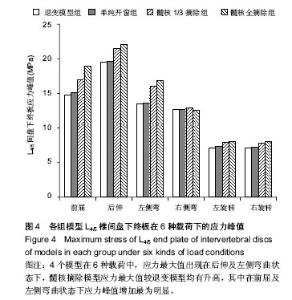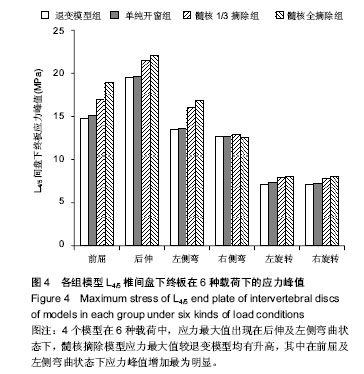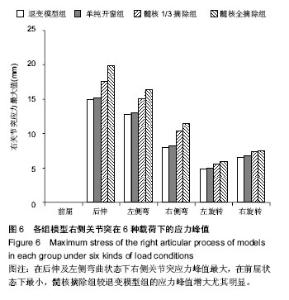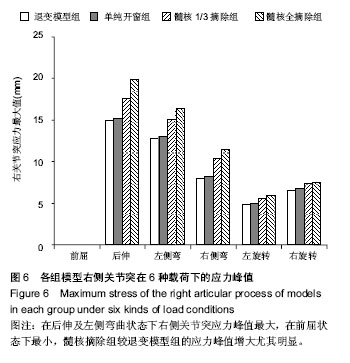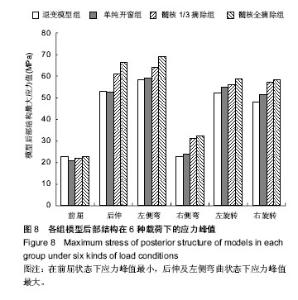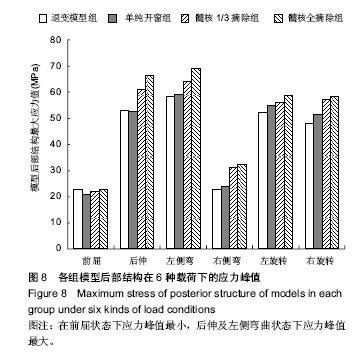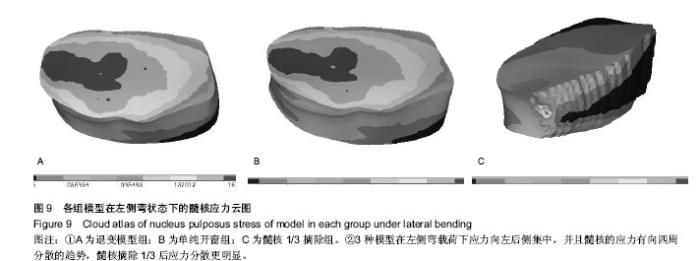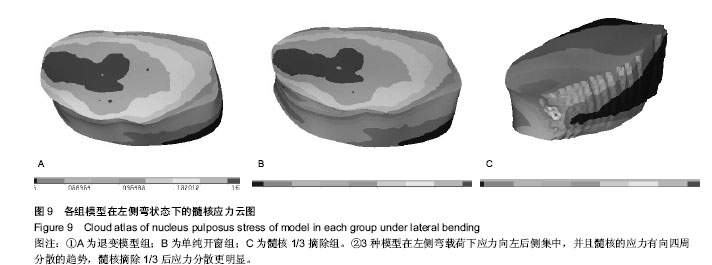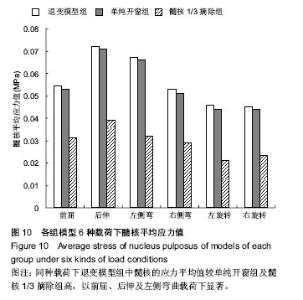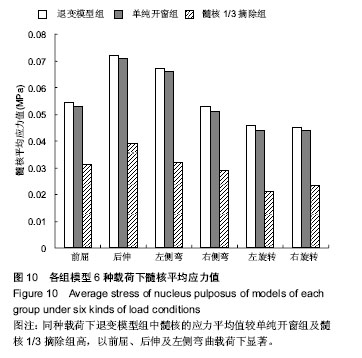Chinese Journal of Tissue Engineering Research ›› 2014, Vol. 18 ›› Issue (17): 2659-2666.doi: 10.3969/j.issn.2095-4344.2014.17.007
Previous Articles Next Articles
Lumbar biomechanical characteristics after microsurgical lumbar discectomy with different proportions of nucleus pulposus: finite element analysis
Chen Hua-xing, Yang Sheng, Lu Jian-min, Yu Yan-nan, Yuan Chi, Ren Fu-quan, Liu Ji-feng, Zhao Guo-quan, Li Shu-qiang
- Department of Orthopedics, Affiliated Zhongshan Hospital of Dalian University, Dalian 116001, Liaoning Province, China
-
Revised:2014-02-28Online:2014-04-23Published:2014-04-23 -
Contact:Yang Sheng, M.D., Professor, Department of Orthopedics, Affiliated Zhongshan Hospital of Dalian University, Dalian 116001, Liaoning Province, China -
About author:Chen Hua-xing, Master, Physician, Department of Orthopedics, Affiliated Zhongshan Hospital of Dalian University, Dalian 116001, Liaoning Province, China -
Supported by:the National Natural Science Foundation of China, No. 30870647
CLC Number:
Cite this article
Chen Hua-xing, Yang Sheng, Lu Jian-min, Yu Yan-nan, Yuan Chi, Ren Fu-quan, Liu Ji-feng, Zhao Guo-quan, Li Shu-qiang. Lumbar biomechanical characteristics after microsurgical lumbar discectomy with different proportions of nucleus pulposus: finite element analysis[J]. Chinese Journal of Tissue Engineering Research, 2014, 18(17): 2659-2666.
share this article
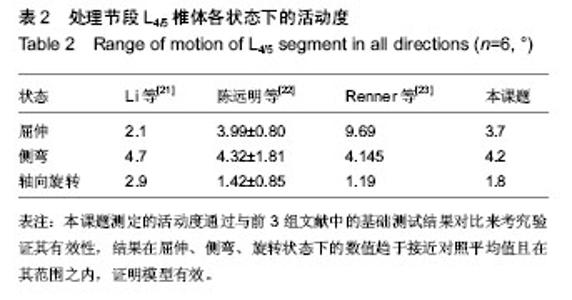
2.1 模型的验证 在分析不同工况下模型的有限元力学特征之前,必须要验证其有效性,理论上要求材料学模拟的结果要与实体研究结果相吻合。将界定载荷后的模型导入Ahaqus 6.9软件中求解,通过处理计算出腰椎运动节段在屈伸、侧弯、轴向旋转状态下的旋转角度,并与文献中的基础测试结果对比来考究其真实性[21-23]。如表2所示,相同的节段采用不同的载荷条件其活动范围有所差异,同等条件下运动节段的活动范围也不尽相同,屈伸和侧弯时ROM相对较大,旋转状态下的ROM相对较小,本文结果趋于接近对照平均值并且在其范围之内,证明模型有效。另一方面,有限元模型的精确度越高则与实体标本的真实程度越接近,单元格的密度越大,数目越多,构建模型的精确度越高。本文中所建立的模型总单元数为438 098个,节点数为135 482个,网格划分的密度有较大的提高,精确度得到有力保证。"
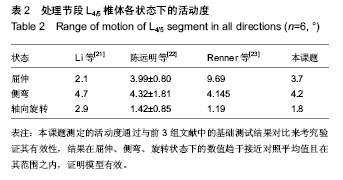
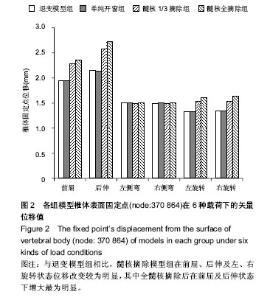
治疗前后5对数值在6种载荷下的位移做配对t检验(满足正态分布),经过SPSS 10.1软件统计分析,结果单纯开窗组与退变模型组在各种载荷下的位移改变差异无显著性意义(P > 0.05);髓核摘除组与退变模型组比较在屈伸及旋转状态下位移改变明显,差异有显著性意义(P < 0.05),在侧弯状态下改变不明显(P > 0.05),说明髓核摘除后在左、右侧弯状态下对腰椎稳定性的影响不大。图2为4组模型在6种载荷下的平均位移图,可以看出单纯开窗组与退变模型组的位移改变影响不大,与退变模型组相比,髓核摘除模型组在前屈、后伸及左、右旋转状态位移改变较为明显,其中全髓核摘除后在前屈及后伸状态下增大最为明显,分别增大了21.65%和26.89%。"
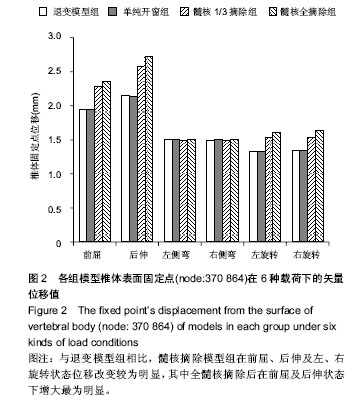

2.3 各组模型终板、髓核、关节突及后部结构的应力分布 造模前后各模型在终板、关节突及后部结构中的应力峰值变化趋势较为相似,总体表现为同一种载荷下退变模型、单纯开窗模型、髓核1/3摘除模型、髓核全摘除模型中应力峰值依次递增。图3为4个模型L4/5椎间盘下终板在前屈状态下的应力云图,图4为4个模型L4/5椎间盘下终板在6种载荷下应力最大值的条形图。可以看出在不同的载荷下,终板的应力集中部位不同,同种载荷下不同模型间的最大应力分布极为相似,前屈、后伸状态下应力分别向终板前下方、后下方集中;左右侧弯载荷下分别集中于左后下方、右后下方;左右旋转载荷下应力分别集中于右后下方、左后下方。4个模型在6种载荷中,应力最大值出现在后伸及左侧弯曲状态下,髓核摘除模型应力最大值较退变模型均有升高,其中在前屈及左侧弯曲状态下应力峰值增加最为明显,髓核全摘除模型较退变模型组分别增大了28.1%和25.32%。"

| [1] 郑启新,邹枕玮,郭晓东,等.腰椎间盘退变性疾病的研究进展及展望[J].中华实验外科杂志,2010,27(11):1573-1576. [2] 黄菊英,李海云,菅凤增.腰椎间盘突出症有限元模型的建立与分析[J].计算机生物力学研究,2012,12(4):394-398. [3] Strange DG, Fisher ST, Boughton PC, et al. Restoration of compressive loading properties of lumbar discs with a nucleus implant: a finite element analysis study. Spine J. 2010;10:602-609. [4] Natarajan RN,Williams JR, Andersson GB. Modeling changes in intervertebral disc mechanics with degeneration. J Bone Joint Surg Am. 2006;88( Suppl 2):36-40. [5] Fessler RG, O' Toole JE, Eichholz KM, et al. The development of minimally invasive spine surgery. Neurosurg Clin N Am. 2006; 17(4):401-409. [6] Bresnahan L, Ogden AT, Natarajan RN, et al. A biomechanical evaluation of graded posterior element removal for treatment of lumbar stenosis: comparison of a minimally invasive approach with two standard laminectomy techniques. Spine (Phila Pa 1976). 2009;34(1):17-23. [7] Hyun SJ, Kim YB, Kim YS, et al. Postoperative changes in paraspinal muscle volume: comparison between paramedian interfascial and midline approaches for lumbar fusion.Korean Med Sci. 2007;4: 646-651. [8] 王本杰,赵德伟,芦健民,等.显微外科微创技术与传统手术治疗腰椎间盘突出症的比较观察[J].中华显微外科杂志,2011, 34(9): 182-184. [9] Rohlmann A, Zander T, Rao M,et al. Applying a follower load delivers realistic results for simulating standing.J Biomech. 2009;42(10):1520-1526. [10] Nakamura T, Iribe T, Asou Y,et al. Effects of compressive loading on biomechanical properties of disc and peripheral tissue in a rat tailmodel. Eur Spine J.2009,18(11):1595- 1603. [11] Kim H, Lim DH, Oh HJ, et al. Effects of nonlinearity in the materials used for the semi-rigid pedicle screw systems on biomechanical behaviors of the lumbar spine after surgery. Biomed Mater. 2011;6(5): 055005. [12] Fagan MJ, Julian S, Mohsen AM. Finite element analysis in spine research. Proc Inst Mech Eng H. 2002;216(5):281- 298. [13] Boger A, Heini P, Windolf M, et al. Adjacent vertebral failure after vertebroplasty: a biomechanical study of low-modulus PMMA cement. Eur Spine J. 2007;16(12):2118-2125. [14] Bowden AE1, Guerin HL, Villarraga ML, et al. Quality of motion considerations in numerical analysis of motion restoring implants of the spine. Clin Biomech (Bristol, Avon). 2008;23(5):536-544. [15] Pitzen T, Geisler F, Matthis D, et al. A finite element model for predicting the biomechanical behaviour of the human lumbar spine. Control Eng Pract. 2002;10:83-90. [16] 黄菊英,李海云,吴浩.腰椎间盘突出症力学特征的仿真计算方法[J].医用生物力学,2012,27(1):96-101. [17] 苏晋,赵文志,陈秉智,等.椎板不同切除范围对腰椎生物力学影响的有限元分析[J].生物医学工程杂志,2012,29(3):466-469. [18] Gu WY, Mao XG, Foster RJ, et al. The anisotropic hydraulic permeability of human lumbar annulus fibrosus. Influence of age, degeneration, direction, and water content. Spine. 1999; 24(23): 2449-2455. [19] Yamamoto I, Panjabi MM, Crisco T, et al. Three-dimensiona, lmovements of the whole lumbar spine and lumbosacral joint. Spine (Phila Pa 1976), 1989;14:1256-1260. [20] Danjabi MM,Abumi K,Duranceau J,et al. Biomechanical evaluation of spinal fixation devices. Spine. 1988;13(10): 11-35. [21] Li G, Wang S, Passias P, et al. Segmental in vivo vertebral motion during functional human lumbar spine activities. Eur Spine. 2009;18:1013-1021. [22] 陈远明,靳安民,陈锋,等.单节段腰椎活动度对邻近节段运动的影响[J].中国组织工程研究与临床康复,2011,15(17):13177-3182. [23] Renner SM,Natarajan RN,Patwardhan AG,et al. Novel model to analyze the effect of a large compressive follower pre-load on range of motions in a lumbar spine. Biomechanics. 2007; 40:1326-1332. [24] 成思源,谢韶旺.Geomagic Studio逆向工程技术及应用[M].北京:清华大学出版社, 2010:63-78. [25] 李海波,方杰,陈其昕,等.髓核摘除术对腰椎生物力学特性影响的有限元研究[J].中国临床解剖学杂志,2011,29(1): 89-93. [26] 宋升,芮永军,孙振,等.模拟腰椎间盘髓核摘除后疲劳载荷对腰椎稳定性的影响[J]中国组织工程研究与临床康复,2011,15(48): 9040-9043. [27] Michalek AJ, Funabashi KL, Iatridis JC. Needle puncture injury of the rat intervertebral disc affects torsional and compressive biomechanics differently. Eur Spine J. 2010, 19(12): 2110-2116. [28] Adams MA,Freeman BJ,Morrison HP, et al. Mechanical initiation of intervertebral disc degeneration. Spine. 2000; 5(13):1625-1636. [29] 迟增德,刘尚礼,李春海,等.腰椎髓核摘除后小关节应力分析[J].中国矫形外科杂志,2009,17(5):377-380. [30] Kuroki H, Goel VK, Holekamp SA, et al. Contributions of flexion-extension cyclic loads to the lumbar spinal segment stability following different discectomy procedures. Spine. 2004;29(3):E39-46. [31] Otoshi K, Kikuchi S, Konno S, et al. The reactions of glial cells and endoneurial macrophages in the dorsal root ganglion and their contribution to pain-related behavior after application of nucleus pulposus onto the nerve root in rats. Spine. 2010;35 (3):264-271. [32] Hayashi S, Taira A, Inoue G, et al. TNF-alpha in nucleus pulposus induces sensory nerve growth : a study of the mechanism of discogenic low back pain using TNF-alpha-deficient mice. Spine. 2008;33(14): 1542-1546. [33] Schulte TL, Leistra F, Bullmann V, et al. Disc height reduction in adjacent segments and clinical outcome 10 years after lumbar 360 degrees fusion. Eur Spine J. 2007;16:2152-2158. [34] Carragee EJ,Spinnickie AO,Alamin TF,et al. A prospective controlled study of limited versus subtotal posterior discectomy short -term outcomes in patients with herniated lumbar intervertebral discs and large posterior annular defect. Spine. 2006;31(6):653-657. [35] Yorimitsu E, Chiba K, Toyama Y, et al. Long-term outcomes of standard discectomy for lumbar disc herniation: a follow-up study of more than 10 years. Spine. 2001;26:652-657. [36] Cinotti G, Roysam GS, Eisenstein SM, et al. Ipsilateral recurrent lumbar disc herniation. J Bone Joint Surg Br. 1998; 80(5):825-832. [37] 侯树勋,李明全,白巍,等.腰椎髓核摘除术远期疗效评价[J].中华骨科杂志,2003,23(9):513-516. [38] 陈学明,刘亚东,许崧杰,等.单节段腰椎间盘突出症单纯髓核摘除术后10年以上随诊观察[J].中国脊柱脊髓杂志,2011,21(8): 644-649. [39] 李玉成,邢星,孙文才,等.人工椎间盘及髓核假体的生物力学[J].中国组织工程研究, 2012,16(22):4169-4172. [40] 宋超,李新锋,刘祖德,等.腰椎棘突间撑开融合器治疗早期腰椎退变的三维有限元分析[J].中华临床医师杂志, 2013,7(3): 1039-1045. [41] 张加芳,郑召民,张奎渤,等.经皮置入式腰椎棘突间撑开器的生物力学测试[J].中国脊柱脊髓杂志, 2011, 21(2):129-132. |
| [1] | Xu Feng, Kang Hui, Wei Tanjun, Xi Jintao. Biomechanical analysis of different fixation methods of pedicle screws for thoracolumbar fracture [J]. Chinese Journal of Tissue Engineering Research, 2021, 25(9): 1313-1317. |
| [2] | Chen Xinmin, Li Wenbiao, Xiong Kaikai, Xiong Xiaoyan, Zheng Liqin, Li Musheng, Zheng Yongze, Lin Ziling. Type A3.3 femoral intertrochanteric fracture with augmented proximal femoral nail anti-rotation in the elderly: finite element analysis of the optimal amount of bone cement [J]. Chinese Journal of Tissue Engineering Research, 2021, 25(9): 1404-1409. |
| [3] | Zhou Jihui, Li Xinzhi, Zhou You, Huang Wei, Chen Wenyao. Multiple problems in the selection of implants for patellar fracture [J]. Chinese Journal of Tissue Engineering Research, 2021, 25(9): 1440-1445. |
| [4] | Liu Xiangxiang, Huang Yunmei, Chen Wenlie, Lin Ruhui, Lu Xiaodong, Li Zuanfang, Xu Yaye, Huang Meiya, Li Xihai. Ultrastructural changes of the white zone cells of the meniscus in a rat model of early osteoarthritis [J]. Chinese Journal of Tissue Engineering Research, 2021, 25(8): 1237-1242. |
| [5] | Xu Yulin, Shen Shi, Zhuo Naiqiang, Yang Huilin, Yang Chao, Li Yang, Zhao Heng, Zhao Lu. Biomechanical comparison of three different plate fixation methods for acetabular posterior column fractures in standing and sitting positions [J]. Chinese Journal of Tissue Engineering Research, 2021, 25(6): 826-830. |
| [6] | Cai Qunbin, Zou Xia, Hu Jiantao, Chen Xinmin, Zheng Liqin, Huang Peizhen, Lin Ziling, Jiang Ziwei. Relationship between tip-apex distance and stability of intertrochanteric femoral fractures with proximal femoral anti-rotation nail: a finite element analysis [J]. Chinese Journal of Tissue Engineering Research, 2021, 25(6): 831-836. |
| [7] | Song Chengjie, Chang Hengrui, Shi Mingxin, Meng Xianzhong. Research progress in biomechanical stability of lateral lumbar interbody fusion [J]. Chinese Journal of Tissue Engineering Research, 2021, 25(6): 923-928. |
| [8] | Liu Zhao, Xu Xilin, Shen Yiwei, Zhang Xiaofeng, Lü Hang, Zhao Jun, Wang Zhengchun, Liu Xuzhuo, Wang Haitao. Guiding role and prospect of staging and classification combined collapse prediction method for osteonecrosis of femoral head [J]. Chinese Journal of Tissue Engineering Research, 2021, 25(6): 929-934. |
| [9] | Xie Chongxin, Zhang Lei. Comparison of knee degeneration after anterior cruciate ligament reconstruction with or without remnant preservation [J]. Chinese Journal of Tissue Engineering Research, 2021, 25(5): 735-740. |
| [10] | Nie Shaobo, Li Jiantao, Sun Jien, Zhao Zhe, Zhao Yanpeng, Zhang Licheng, Tang Peifu. Mechanical stability of medial support nail in treatment of severe osteoporotic intertrochanteric fracture [J]. Chinese Journal of Tissue Engineering Research, 2021, 25(3): 329-333. |
| [11] | Tan Jiachang, Yuan Zhenchao, Wu Zhenjie, Liu Bin, Zhao Jinmin. Biomechanical analysis of elastic nail combined with end caps and wire fixation for long oblique femoral shaft fractures [J]. Chinese Journal of Tissue Engineering Research, 2021, 25(3): 334-338. |
| [12] | Chen Lu, Zhang Jianguang, Deng Changgong, Yan Caiping, Zhang Wei, Zhang Yuan. Finite element analysis of locking screw assisted acetabular cup fixation [J]. Chinese Journal of Tissue Engineering Research, 2021, 25(3): 356-361. |
| [13] | Zhou Jihui, Li Xinzhi, Zhou You, Huang Wei, Chen Wenyao. Comparison of the advantages and disadvantages of multiple implants in treatment of traumatic dislocation of sternoclavicular joint [J]. Chinese Journal of Tissue Engineering Research, 2021, 25(3): 443-448. |
| [14] | Li Kun, Li Zhijun, Zhang Shaojie, Gao Shang, Sun Hao, Yang Xi, Wang Xing, Dai Lina . A 4-year-old child model of occipito-atlanto-axial joints established by finite element dynamic simulation [J]. Chinese Journal of Tissue Engineering Research, 2021, 25(24): 3773-3778. |
| [15] | Shu Qihang, Liao Yijia, Xue Jingbo, Yan Yiguo, Wang Cheng. Three-dimensional finite element analysis of a new three-dimensional printed porous fusion cage for cervical vertebra [J]. Chinese Journal of Tissue Engineering Research, 2021, 25(24): 3810-3815. |
| Viewed | ||||||
|
Full text |
|
|||||
|
Abstract |
|
|||||


